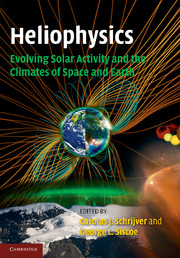Book contents
- Frontmatter
- Contents
- Preface
- 1 Interconnectedness in heliophysics
- 2 Long-term evolution of magnetic activity of Sun-like stars
- 3 Formation and early evolution of stars and protoplanetary disks
- 4 Planetary habitability on astronomical time scales
- 5 Solar internal flows and dynamo action
- 6 Modeling solar and stellar dynamos
- 7 Planetary fields and dynamos
- 8 The structure and evolution of the three-dimensional solar wind
- 9 The heliosphere and cosmic rays
- 10 Solar spectral irradiance: measurements and models
- 11 Astrophysical influences on planetary climate systems
- 12 Assessing the Sun–climate relationship in paleoclimate records
- 13 Terrestrial ionospheres
- 14 Long-term evolution of the geospace climate
- 15 Waves and transport processes in atmospheres and oceans
- 16 Solar variability, climate, and atmospheric photochemistry
- Appendix I Authors and editors
- List of illustrations
- List of tables
- References
- Index
- Plates
12 - Assessing the Sun–climate relationship in paleoclimate records
Published online by Cambridge University Press: 05 April 2013
- Frontmatter
- Contents
- Preface
- 1 Interconnectedness in heliophysics
- 2 Long-term evolution of magnetic activity of Sun-like stars
- 3 Formation and early evolution of stars and protoplanetary disks
- 4 Planetary habitability on astronomical time scales
- 5 Solar internal flows and dynamo action
- 6 Modeling solar and stellar dynamos
- 7 Planetary fields and dynamos
- 8 The structure and evolution of the three-dimensional solar wind
- 9 The heliosphere and cosmic rays
- 10 Solar spectral irradiance: measurements and models
- 11 Astrophysical influences on planetary climate systems
- 12 Assessing the Sun–climate relationship in paleoclimate records
- 13 Terrestrial ionospheres
- 14 Long-term evolution of the geospace climate
- 15 Waves and transport processes in atmospheres and oceans
- 16 Solar variability, climate, and atmospheric photochemistry
- Appendix I Authors and editors
- List of illustrations
- List of tables
- References
- Index
- Plates
Summary
Introduction
One could write an interesting essay on the twists and turns in Sun–Earth climate science, addressing both the instrumental record and the much longer interval of paleoclimate records. The conclusion at the time of this writing with respect to the importance of low-frequency solar variability in the most recent decades, and perhaps up to centuries, might be “Perhaps, but probably small”. The main reasons why uncertainties persist regarding this issue include:
(i) The ˜ 150-year instrumental record is too short to draw definitive statistical conclusions about the connection of any relation existing on the multi-decadal time scale.
(ii) Forcing from anthropogenic greenhouse gases represents a significant overprint on trends since about 1850 CE. Because to first order the trends in proxies for solar activity indices and in greenhouse gas concentrations are similar, there is a statistical degeneracy that leads to ambiguous, and thus potentially misleading, conclusions unless great care is taken.
(iii) A similar problem of statistical degeneracy applies to the Little Ice Age interval of cool conditions during the last millennium (main phase about 1450–1850 CE), when mountain glaciers advanced in many regions and planetary temperatures were about 0.5°C lower (e.g. Jones and Mann, 2003; Hegerl et al., 2007). During the Little Ice Age, solar activity, as inferred from changes in radiogenic isotopes such as 14C and 10Be, appears to have varied similarly to pulses in volcanism and slightly lower carbon dioxide (CO2) levels (further discussed below).
- Type
- Chapter
- Information
- Publisher: Cambridge University PressPrint publication year: 2010



